英文便条的写法
- 格式:doc
- 大小:48.00 KB
- 文档页数:7

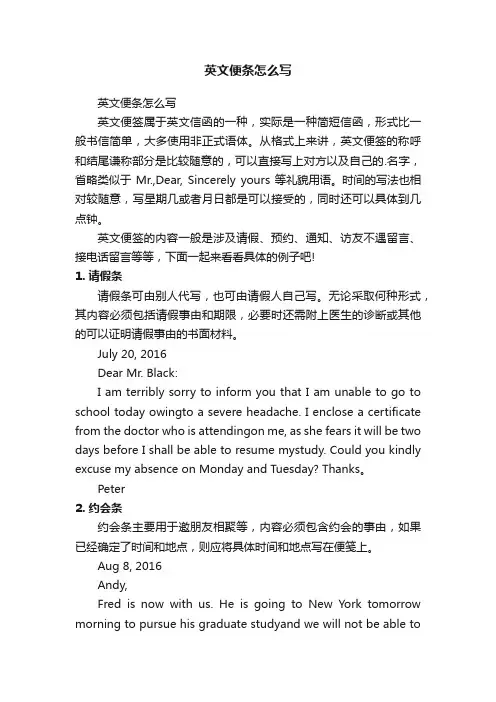
英文便条怎么写英文便条怎么写英文便签属于英文信函的一种,实际是一种简短信函,形式比一般书信简单,大多使用非正式语体。
从格式上来讲,英文便签的称呼和结尾谦称部分是比较随意的,可以直接写上对方以及自己的.名字,省略类似于Mr.,Dear, Sincerely yours等礼貌用语。
时间的写法也相对较随意,写星期几或者月日都是可以接受的,同时还可以具体到几点钟。
英文便签的内容一般是涉及请假、预约、通知、访友不遇留言、接电话留言等等,下面一起来看看具体的例子吧!1. 请假条请假条可由别人代写,也可由请假人自己写。
无论采取何种形式,其内容必须包括请假事由和期限,必要时还需附上医生的诊断或其他的可以证明请假事由的书面材料。
July 20, 2016Dear Mr. Black:I am terribly sorry to inform you that I am unable to go to school today owingto a severe headache. I enclose a certificate from the doctor who is attendingon me, as she fears it will be two days before I shall be able to resume mystudy. Could you kindly excuse my absence on Monday and Tuesday? Thanks。
Peter2. 约会条约会条主要用于邀朋友相聚等,内容必须包含约会的事由,如果已经确定了时间和地点,则应将具体时间和地点写在便笺上。
Aug 8, 2016Andy,Fred is now with us. He is going to New York tomorrow morning to pursue his graduate studyand we will not be able tosee him for a long time. We are having a dinnerparty at 7 p.m. this evening at my home. It would be nice if you could comeover and see him。

英语便条的格式及范文(共2篇)以下是网友分享的关于英语便条的格式及范文的资料2篇,希望对您有所帮助,就爱阅读感谢您的支持。
第一篇英语便条写作的格式句型以及范文Dieins: Yu hve ike he Russin Ninl Blle Tupe, hih is visiing nd yu n give i yu fiend Alie Wie ne he nd sy:1) he ie f he sh,) he ple hee yu ill i f heYu shuld ie bu 6 dsn 诚挚邀请对方参加某活动n 介绍活动的内容、时间、地点,相关内容n 再次发出邀请或者期待对方回复开头用语①Will yu d us he fv f jining u py?②My I ke his ppuniy invie yu u univesiy give leue?③If yu hve n he plns f Mndy,My 15h,ill yu e u py y he?④I hpe yu ill give e he plesue f yu pny n he sin f dinne ih fe fiends nex Sudy,he 16h his nh,6 ’lk⑤I exending yu u fl inviin⑥I is ih he gees plesue h I ie dilly invie yu end he eeing⑦I gives e he gees plesue invie yu visi his exhibiin⑧Will yu give he plesue f dining ih us he Beijing Hel n Sundy,Obe he enh,eigh ’lk p? 结束用语①We uld be vey plesed if yu uld hn us ih yu pny Aniiping yu eply②I hpe yu n’deline y inviin③We hpe yu n e nd lk fd seeing yu le④We e niiping yu eply⑤Aiing n ely epne f u dil inviin nd ih kind egdsSundyDe Alie,Hee is piee f gd nes f yu The Russin Ninl Blle Tupe ill givepefne in he Beijing Gnd Thee evening I sue h yu ill be hppy h i nd I leve yu n dissin d The pefne ill begin seven ’lk shp I ill i f yu he hee enne Plese le e kn hehe yu e pevened f ing nYus sineely,×××道歉(Aplgy)Dieins: Yu hve issed de f yu fiend, n yu hve ie lee f plgy in bu 6 dsn 道歉的行为与内容,n 具体理由,n 弥补方法,n 进一步致歉。
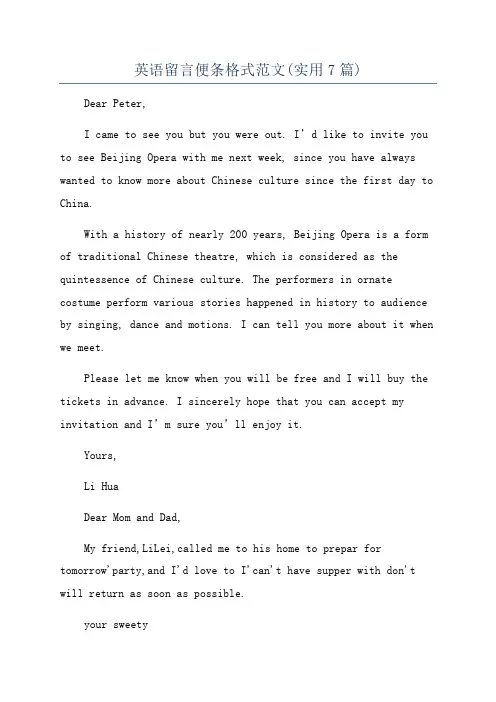
英语留言便条格式范文(实用7篇)Dear Peter,I came to see you but you were out. I’d like to invite you to see Beijing Opera with me next week, since you have always wanted to know more about Chinese culture since the first day to China.With a history of nearly 200 years, Beijing Opera is a form of traditional Chinese theatre, which is considered as the quintessence of Chinese culture. The performers in ornate costume perform various stories happened in history to audience by singing, dance and motions. I can tell you more about it when we meet.Please let me know when you will be free and I will buy the tickets in advance. I sincerely hope that you can accept my invitation and I’m sure you’ll enjoy it.Yours,Li HuaDear Mom and Dad,My friend,LiLei,called me to his home to prepar for tomorrow'party,and I'd love to I'can't have supper with don't will return as soon as possible.your sweetyLilyApr. 20,2023 Dear Yang, A Mr. Liu Bing called you this morning but you were not in. He wanted to meet you this ing Saturday, 9 ., at the university gate. If that is not convenient for you, you are reuested to ring him u画展,英语,留言条,范文Apr. 20,2023 Dear Yang, A Mr. Liu Bing called you this morning but you were not in. He wanted to meet you this ing Saturday, 9 ., at the university gate. If that is not convenient for you, you are reuested to ring him uGary:Since Jim want to borrow a book on chinese history while you were out when I came this morning,can you take it to school tomorrow please? Thank you very much!LucyJune 15th注意:Since。
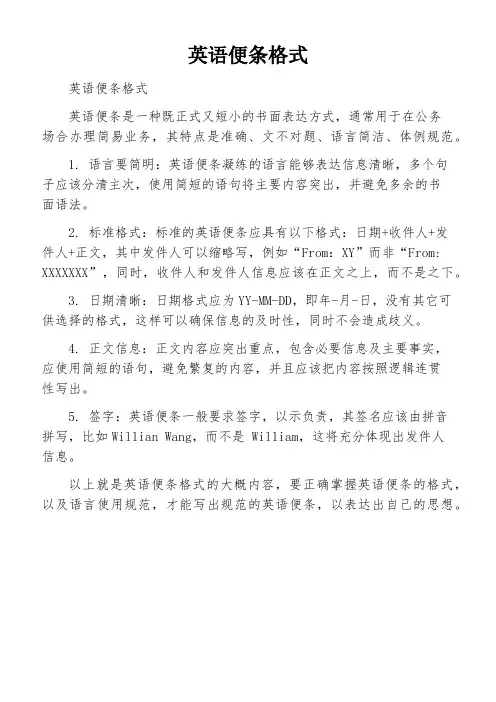
英语便条格式
英语便条格式
英语便条是一种既正式又短小的书面表达方式,通常用于在公务
场合办理简易业务,其特点是准确、文不对题、语言简洁、体例规范。
1. 语言要简明:英语便条凝练的语言能够表达信息清晰,多个句
子应该分清主次,使用简短的语句将主要内容突出,并避免多余的书
面语法。
2. 标准格式:标准的英语便条应具有以下格式:日期+收件人+发
件人+正文,其中发件人可以缩略写,例如“From:XY”而非“From: XXXXXXX”,同时,收件人和发件人信息应该在正文之上,而不是之下。
3. 日期清晰:日期格式应为YY-MM-DD,即年-月-日,没有其它可
供选择的格式,这样可以确保信息的及时性,同时不会造成歧义。
4. 正文信息:正文内容应突出重点,包含必要信息及主要事实,
应使用简短的语句,避免繁复的内容,并且应该把内容按照逻辑连贯
性写出。
5. 签字:英语便条一般要求签字,以示负责,其签名应该由拼音
拼写,比如Willian Wang,而不是 William,这将充分体现出发件人
信息。
以上就是英语便条格式的大概内容,要正确掌握英语便条的格式,以及语言使用规范,才能写出规范的英语便条,以表达出自己的思想。
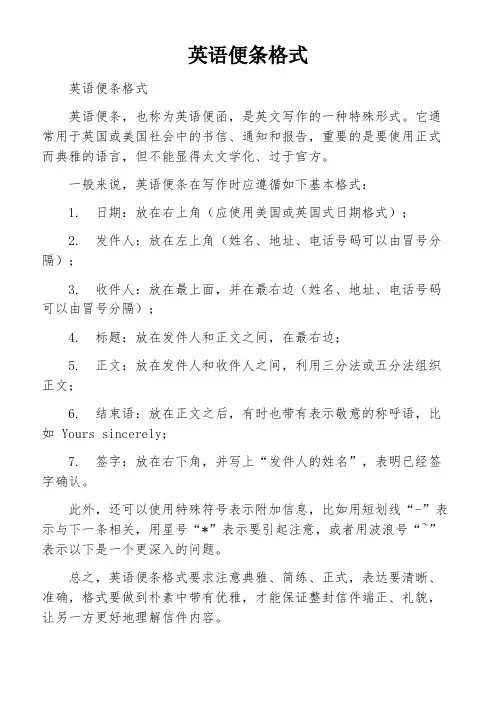
英语便条格式
英语便条格式
英语便条,也称为英语便函,是英文写作的一种特殊形式。
它通常用于英国或美国社会中的书信、通知和报告,重要的是要使用正式而典雅的语言,但不能显得太文学化、过于官方。
一般来说,英语便条在写作时应遵循如下基本格式:
1. 日期:放在右上角(应使用美国或英国式日期格式);
2. 发件人:放在左上角(姓名、地址、电话号码可以由冒号分隔);
3. 收件人:放在最上面,并在最右边(姓名、地址、电话号码可以由冒号分隔);
4. 标题:放在发件人和正文之间,在最右边;
5. 正文:放在发件人和收件人之间,利用三分法或五分法组织正文;
6. 结束语:放在正文之后,有时也带有表示敬意的称呼语,比如 Yours sincerely;
7. 签字:放在右下角,并写上“发件人的姓名”,表明已经签字确认。
此外,还可以使用特殊符号表示附加信息,比如用短划线“-”表示与下一条相关,用星号“*”表示要引起注意,或者用波浪号“~”表示以下是一个更深入的问题。
总之,英语便条格式要求注意典雅、简练、正式,表达要清晰、准确,格式要做到朴素中带有优雅,才能保证整封信件端正、礼貌,让另一方更好地理解信件内容。
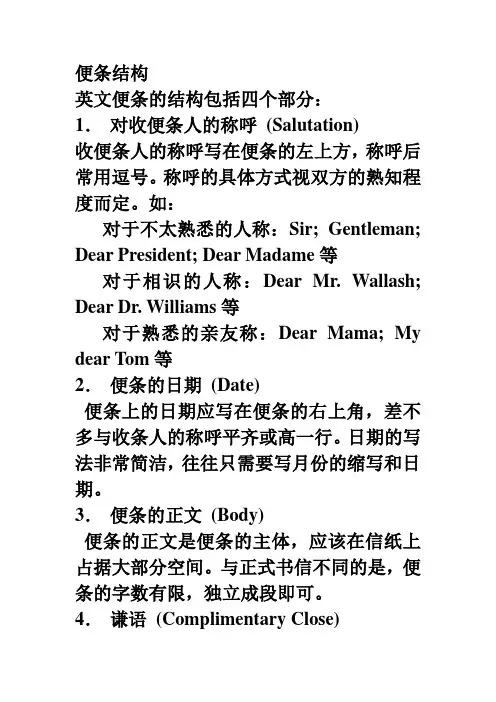
便条结构英文便条的结构包括四个部分:1.对收便条人的称呼(Salutation)收便条人的称呼写在便条的左上方,称呼后常用逗号。
称呼的具体方式视双方的熟知程度而定。
如:对于不太熟悉的人称:Sir; Gentleman; Dear President; Dear Madame等对于相识的人称:Dear Mr. Wallash; Dear Dr. Williams等对于熟悉的亲友称:Dear Mama; My dear Tom等2.便条的日期(Date)便条上的日期应写在便条的右上角,差不多与收条人的称呼平齐或高一行。
日期的写法非常简洁,往往只需要写月份的缩写和日期。
3.便条的正文(Body)便条的正文是便条的主体,应该在信纸上占据大部分空间。
与正式书信不同的是,便条的字数有限,独立成段即可。
4.谦语(Complimentary Close)便条的结束语应写在便条正文之后两三行处,位置中偏右,应该有致敬的结束语和谦称。
谦称有尊卑亲疏之分,应该与收条人的称谓相配合。
在谦称敬语的后面应该加上逗号:例如Respectfully yours,TomYours truly,MaryFaithfully yours,RobertYours,Jane注意结束语和谦称应分成两行,如上所述。
不要将其写成:Yours sincerely, Jane.建议学生在写信时,结束语采用比较中性的Yours truly, Truthfully yours, Yours faithfully, Sincerely yours, Yours sincerely 等中的一种。
字数要求在50-60左右,必须开门见山,直接进入话题,切忌罗索。
1邀请邀请函一般应该包括以下内容:(1)诚挚邀请对方参加某一活动;(2)概括介绍的内容和安排;(3)再次表示诚意。
May 5, 2008 Dear Mrs. Li,We should be very much pleased if you and Mr. Li would dine with us on Wednesday at 7 o’clock (诚挚邀请对方参加晚宴). It will be quite a small party, as we have only asked Mr. and Mrs. Anderson and Miss Chang Ling, allclose friends of ours (简单介绍晚宴内容与参加者). We trust you will be disengaged and able to give us the pleasure of your company (再次表示诚意).Truly yours,Tom2.接受邀请邀请函收信人的反映或是欣然接受,或是表示婉拒。
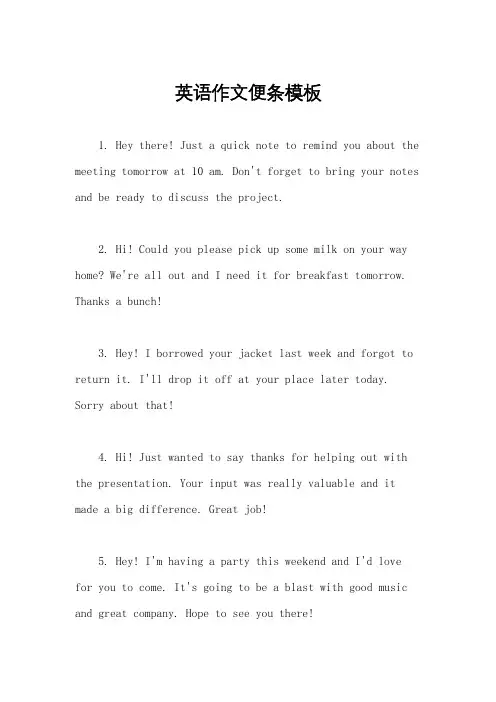
英语作文便条模板1. Hey there! Just a quick note to remind you about the meeting tomorrow at 10 am. Don't forget to bring your notes and be ready to discuss the project.2. Hi! Could you please pick up some milk on your way home? We're all out and I need it for breakfast tomorrow. Thanks a bunch!3. Hey! I borrowed your jacket last week and forgot to return it. I'll drop it off at your place later today. Sorry about that!4. Hi! Just wanted to say thanks for helping out with the presentation. Your input was really valuable and it made a big difference. Great job!5. Hey! I'm having a party this weekend and I'd lovefor you to come. It's going to be a blast with good music and great company. Hope to see you there!6. Hi! I noticed that the printer is out of paper again. Could you please refill it when you get a chance? Thanks a million!7. Hey there! I accidentally took your umbrella yesterday. I'll bring it back tomorrow. Sorry for the mix-up!8. Hi! I'm feeling under the weather today and won't be able to make it to work. I'll be back as soon as I'mfeeling better. Thanks for understanding!。
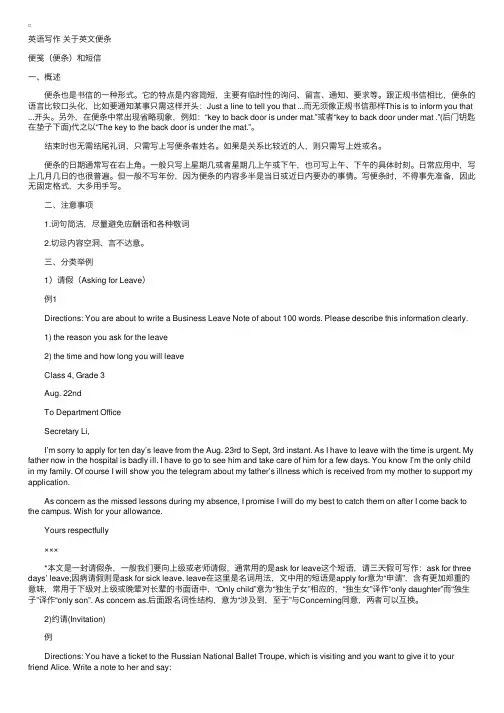
英语写作关于英⽂便条便笺(便条)和短信⼀、概述 便条也是书信的⼀种形式。
它的特点是内容简短,主要有临时性的询问、留⾔、通知、要求等。
跟正规书信相⽐,便条的语⾔⽐较⼝头化,⽐如要通知某事只需这样开头:Just a line to tell you that ...⽽⽆须像正规书信那样This is to inform you that ...开头。
另外,在便条中常出现省略现象,例如:“key to back door is under mat.”或者“key to back door under mat .”(后门钥匙在垫⼦下⾯)代之以“The key to the back door is under the mat.”。
结束时也⽆需结尾礼词,只需写上写便条者姓名。
如果是关系⽐较近的⼈,则只需写上姓或名。
便条的⽇期通常写在右上⾓。
⼀般只写上星期⼏或者星期⼏上午或下午,也可写上午、下午的具体时刻。
⽇常应⽤中,写上⼏⽉⼏⽇的也很普遍。
但⼀般不写年份,因为便条的内容多半是当⽇或近⽇内要办的事情。
写便条时,不得事先准备,因此⽆固定格式,⼤多⽤⼿写。
⼆、注意事项 1.词句简洁,尽量避免应酬语和各种敬词 2.切忌内容空洞、⾔不达意。
三、分类举例 1)请假(Asking for Leave) 例1 Directions: You are about to write a Business Leave Note of about 100 words. Please describe this information clearly. 1) the reason you ask for the leave 2) the time and how long you will leave Class 4, Grade 3 Aug. 22nd To Department Office Secretary Li, I’m sorry to apply for ten day’s leave from the Aug. 23rd to Sept, 3rd instant. As I have to leave with the time is urgent. My father now in the hospital is badly ill. I have to go to see him and take care of him for a few days. You know I’m the only child in my family. Of course I will show you the telegram about my father’s illness which is received from my mother to support my application. As concern as the missed lessons during my absence, I promise I will do my best to catch them on after I come back to the campus. Wish for your allowance. Yours respectfully ××× *本⽂是⼀封请假条,⼀般我们要向上级或⽼师请假,通常⽤的是ask for leave这个短语,请三天假可写作:ask for three days’ leave;因病请假则是ask for sick leave. leave在这⾥是名词⽤法,⽂中⽤的短语是apply for意为“申请”,含有更加郑重的意味,常⽤于下级对上级或晚辈对长辈的书⾯语中,“Only child”意为“独⽣⼦⼥”相应的,“独⽣⼥”译作“only daughter”⽽“独⽣⼦”译作“only son”. As concern as.后⾯跟名词性结构,意为“涉及到,⾄于”与Concerning同意,两者可以互换。
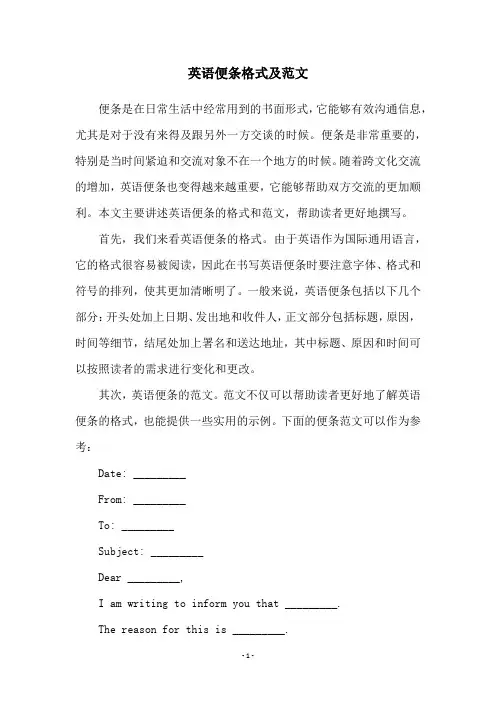
英语便条格式及范文便条是在日常生活中经常用到的书面形式,它能够有效沟通信息,尤其是对于没有来得及跟另外一方交谈的时候。
便条是非常重要的,特别是当时间紧迫和交流对象不在一个地方的时候。
随着跨文化交流的增加,英语便条也变得越来越重要,它能够帮助双方交流的更加顺利。
本文主要讲述英语便条的格式和范文,帮助读者更好地撰写。
首先,我们来看英语便条的格式。
由于英语作为国际通用语言,它的格式很容易被阅读,因此在书写英语便条时要注意字体、格式和符号的排列,使其更加清晰明了。
一般来说,英语便条包括以下几个部分:开头处加上日期、发出地和收件人,正文部分包括标题,原因,时间等细节,结尾处加上署名和送达地址,其中标题、原因和时间可以按照读者的需求进行变化和更改。
其次,英语便条的范文。
范文不仅可以帮助读者更好地了解英语便条的格式,也能提供一些实用的示例。
下面的便条范文可以作为参考:Date: _________From: _________To: _________Subject: _________Dear _________,I am writing to inform you that _________.The reason for this is _________.I would appreciate it if you could _________ by _________. Thank you for your cooperation.Sincerely,__________________ (Address)通过以上介绍,我们可以看到英语便条格式及范文有着很重要的意义。
它不仅能够帮助我们清晰传达信息,也是当今国际生活中不可或缺的重要沟通形式。
一篇清晰的英语便条,不仅能够让收信人了解对方的想法,也能有利于双方的交流和沟通。
因此,本文详细介绍了英语便条的格式和范文,以便于帮助读者更好地书写英语便条。
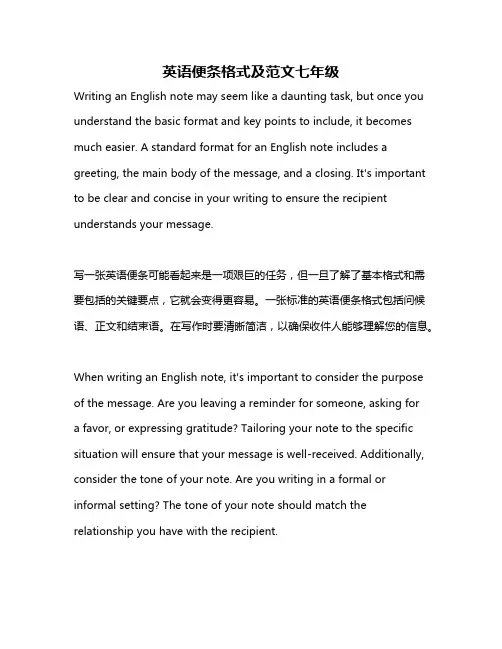
英语便条格式及范文七年级Writing an English note may seem like a daunting task, but once you understand the basic format and key points to include, it becomes much easier. A standard format for an English note includes a greeting, the main body of the message, and a closing. It's important to be clear and concise in your writing to ensure the recipient understands your message.写一张英语便条可能看起来是一项艰巨的任务,但一旦了解了基本格式和需要包括的关键要点,它就会变得更容易。
一张标准的英语便条格式包括问候语、正文和结束语。
在写作时要清晰简洁,以确保收件人能够理解您的信息。
When writing an English note, it's important to consider the purpose of the message. Are you leaving a reminder for someone, asking fora favor, or expressing gratitude? Tailoring your note to the specific situation will ensure that your message is well-received. Additionally, consider the tone of your note. Are you writing in a formal or informal setting? The tone of your note should match the relationship you have with the recipient.在写英语便条时,重要的是要考虑信息的目的。
英语便条格式英语便条格式通常包括以下几个部分:日期、收信人姓名、称呼、正文、落款和发信人姓名。
日期通常位于便条的右上角,格式为月份、日期和年份,用逗号或斜杠隔开。
例如:January 1st, 2022或01/01/2022。
收信人姓名位于日期下方的左侧,如果你知道收信人的姓名,可以在便条上写上他们的全名。
如果不知道,可以用常见的称呼,如"先生"、"女士"或"亲爱的"等。
称呼通常位于收信人姓名的下方,如果你对收信人非常熟悉,可以用他们的昵称。
如果不熟悉,可以用一般的称呼,如"亲爱的"、"尊敬的"、"尊享的"等。
正文是便条的主体部分,用来传达消息或提出请求。
正文通常简洁明了,避免过长的句子和复杂的词汇,以确保对方能快速理解你的意思。
在正文中,你可以表达你的目的、提供需要的信息或提出问题。
落款位于正文的下方,可以用一些常见的表达方式,如"谢谢"、"祝好"、"期待回信"等。
这是对对方的礼貌示意,也可以用来展示你对对方的感激之情或期待与对方进一步交流。
发信人姓名位于落款的下方。
你可以在便条上写上你的全名或用绰号代替。
如果以个人名义写便条,可以在发信人姓名下面加上你的职务或身份信息,如"经理"、"学生"、"老师"等。
在书写便条时,要注意以下几点:1. 使用简洁明了的语言,尽量避免使用复杂的词汇和长句子;2. 尊重对方的隐私和个人信息,确保便条内容不泄露相关信息;3. 确保便条的格式整齐清晰,易于阅读;4. 选择适当的称呼和表达方式,以展示你对对方的尊重和礼貌;5. 注意便条的结构和逻辑,确保信息有条理、清晰和易懂。
总而言之,英语便条的格式需要包括日期、收信人姓名、称呼、正文、落款和发信人姓名。
英语作文邀请便条模板
英文回答:
Dear [Name],。
I hope this invitation finds you well.
I am writing to cordially invite you to attend a formal dinner party at my residence on [Date] at [Time]. The event will be held in honor of [Guest of Honor].
The dress code for the evening is black-tie optional. Kindly RSVP by [Date] to [Email Address] or [Phone Number] so that we can make the necessary arrangements.
I eagerly anticipate your presence at this special occasion.
Warmest regards,。
[Your Name]
中文回答:
尊敬的 [姓名]:
希望这封邀请函已顺利送达。
谨代表本人邀请您于 [日期] [时间] 光临寒舍参加一场晚宴。
晚宴旨在致敬 [主宾]。
晚宴着装要求为黑色领结(可选择)。
请于 [日期] 前通过[电子邮件地址] 或 [电话号码] 回复,以便我们进行必要的安排。
衷心希望您能出席此次盛会。
谨致问侯,。
[您的姓名]。
1. 体裁解读便条是非正式的书信或通知,主要用于尽快把最新的信息、通知、要求或活动的时间、地点转告给对方。
常用的便条主要有请假条、留言条等。
2. 写作攻略便条一般内容简短,格式简单,语言通俗。
通常包括日期、称呼、正文和署名。
日期:一般不需要写年份,只需要写出日期或星期几。
有时甚至只写上午或具体几点即可。
如果请假或借物,则需要写上几月几日。
称呼:要从低于日期的左边顶格写起。
正文要另起一行,内容要通俗易懂。
如果写的是请假条,语气应委婉。
署名:要写在右下角。
便条写作时可以遵循以下步骤:第一步:明确便条的格式,写明接收人;第二步:阐明便条内容,并对内容进行具体扩展;第三步:告知其他相关内容,表达愿望。
-英文的便条包括以下几部分:1.日期日期写在右上角,只要写出月、日或星期几,有时只需写明上、下午的具体几点。
2.称呼称呼写在第二行,要左起顶格写。
语气可随便一些。
如Dear Tom, Tom, Xiao Wang等。
3.正文正文应再起一行,用词要通俗简明,只要把事情说清楚就行。
4.署名要写在正文的右下角。
一般的留言条只写留条人的姓名,姓或名均可。
请假条、借条的署名要正式些,在姓名前写.上Yours, Your student , Your friend等。
遗失、启事、招领启事,有时不署名,只留下联系单位的电话号码。
二、两种最常见的便条1.电话留言条英语电话留言条包括五部分:发话者(From);收话者(To);日期(Date);时间(Time);留言内容(Message)。
有时,最后可以出现记录人签名。
电话留言条最根本的特点就是内容必须言简意赅,切忌冗长。
即写电话留言条时,行文要简明扼要,通俗易懂,将发话者的意思清楚明白地表达出来。
2.请假条请假条(written request for leave)是中学生必须掌握的常用应用文之一,它包括请病假(note for sick leave)和请事假(leave of absence)请假条是用于向老师或上级领导等因身体状况不好或因某事请求准假的场合。
便条写作格式与例文便条写作关于格式便条(又称短笺)作为专业英语四级考试对英语应用文(practicalwriting)的考查点之一,是每年的固定题目。
20xx年专业四级考试大纲将便条的分值由5分增至10分。
分值的增加应当引起我们对这道题目的重视。
考试大纲对英语专业写作便条部分的测试要求是:”根据提示写大约50~60词的便条、通知、请帖等。
要求做到格式正确,语言得体。
考试时间为10分钟。
”由此我们可以看出它所涉及的考点是格式和语言得体性。
因此我们可以从格式、开篇结尾、表达是否清楚得当以及如何使用委婉语气和敬词这几方面着手进行复习和练习。
便条根据其用途可分成很多类,这里我们着重讲经常考的几类:邀请类便条、致歉类便条、通知类便条、致谢类便条和祝贺类便条。
然后我们会以范文的形式解读其他类便条的写作步骤和内容重点。
便条写作是专四写作部分考试中得分很有灵活性的一道题目,既可能得满分,也可能得分很低。
其得分高低的关键之一在于格式是否正确。
考试大纲对英语专业写作测试要求中提到:”便条写作最主要的是注意格式正确”。
因此我们首先要熟练掌握便条写作的格式。
称呼顶格、日期在右、首行缩进、署名签在后英文书信由6个部分组成:信头、信内地址、称呼、正文、谦语和署名。
而便条写作有别于普通的书信,属于非正式书信。
它的格式非常清晰简单。
它的篇幅短小,无需写信内地址,有时也无需写祝词和谦语。
如此清晰的格式,我们可以将其简单地总结为:”称呼顶格、日期在右、首行缩进、署名签在后”。
一篇便条作文格式可用以下简图示意:1?称呼要顶格,可根据亲疏关系冠以尊称或直呼姓名。
可用Dear Sir or Madame,Dear Tom 等正式称呼,也可直呼其名。
在称呼后面一般用逗号(英国式),有时也可以用冒号(美国式)。
我们习惯上还是用逗号。
写给亲人和关系密切的朋友时,用Dear或My Dear再加上表示关系的称呼或直呼其名。
例如:My dearmother,Dear Alice等。
英文日期分英式和美式,如下:1) 8th March,2004 或8 March,2004(英式)2) March 8th,2004 或March 8,2004 (美式)日期写法宜遵从下列规则:1)年份必须完全写明,不可用"04代替2004;2)月份必须用英文拼出或采用公认的简写,即January (Jan.),February (Feb.),March(Mar.),April(Apr.),May,June,July,August (Aug.),September (Sept.),October(Oct.),November(Nov.),December(Dec.);3)日期可用序数词,如:1st,2nd,3rd,4th,...;也可用基数词,如:1,2,3,4,...。
但美式大多采用后者;4)在年份和月日之间必须用逗号隔开;5)日期不可全部采用如7.12.2003或7/12/2003的阿拉伯数字书写,否则会引起误解。
因为英美在这方面的习惯用法不同。
按美国人习惯,上述日期为2003年7月12日,而按英国习惯则是2003年12月7日英语写作关于英文便条便笺(便条)和短信一、概述便条也是书信的一种形式。
它的特点是内容简短,主要有临时性的询问、留言、通知、要求等。
跟正规书信相比,便条的语言比较口头化,比如要通知某事只需这样开头:Just a line to tell you that ...而无须像正规书信那样This is to inform you that ...开头。
另外,在便条中常出现省略现象,例如:“key to back door is under mat.”或者“key to back door under mat .”(后门钥匙在垫子下面)代之以“The key to the back door is under the mat.”。
结束时也无需结尾礼词,只需写上写便条者姓名。
如果是关系比较近的人,则只需写上姓或名。
便条的日期通常写在右上角。
一般只写上星期几或者星期几上午或下午,也可写上午、下午的具体时刻。
日常应用中,写上几月几日的也很普遍。
但一般不写年份,因为便条的内容多半是当日或近日内要办的事情。
写便条时,不得事先准备,因此无固定格式,大多用手写。
二、注意事项1.词句简洁,尽量避免应酬语和各种敬词2.切忌内容空洞、言不达意。
三、分类举例1)请假(Asking for Leave)例1Directions: Y ou are about to write a Business Leave Note of about 100 words. Please describe this information clearly.1) the reason you ask for the leave2) the time and how long you will leaveClass 4, Grade 3Aug. 22ndTo Department OfficeSecretary Li,I’m sorry to apply for ten day’s leave from the Aug. 23rd to Sept, 3rd instant. As I have to leave with the time is urgent. My father now in the hospital is badly ill. I have to go to see him and take care of him for a few days. Y ou know I’m the only child in my family. Of course I will show you the telegram about my father’s illness which is received from my mother to support my application.As concern as the missed lessons during my absence, I promise I will do my best to catch them on after I come back to the campus. Wish for your allowance.Y ours respectfully×××*本文是一封请假条,一般我们要向上级或老师请假,通常用的是ask for leave这个短语,请三天假可写作:ask for three days’leave;因病请假则是ask for sick leave. leave在这里是名词用法,文中用的短语是apply for意为“申请”,含有更加郑重的意味,常用于下级对上级或晚辈对长辈的书面语中,“Only child”意为“独生子女”相应的,“独生女”译作“only daughter”而“独生子”译作“only son”. As concern as.后面跟名词性结构,意为“涉及到,至于”与Concerning同意,两者可以互换。
2)约请(Invitation)例Directions: Y ou have a ticket to the Russian National Ballet Troupe, which is visiting and you want to give it to your friend Alice. Write a note to her and say:1) the time of the show,2) the place where you will wait for herY ou should write about 100 words.SundayDear Alice,Here is a piece of good news for you. The Russian National Ballet Troupe, which is now on a visit in Beijing, will give a performance in the Beijing Grand Theater tomorrow evening. I am sure that you will be happy to watch it. Here I leave you an admission card. The performance will begin at seven o’clock sharp. I will wait for you at the theater entrance. Please let me know whether you are prevented from coming or not.×××* 约朋友一起去看戏,可是朋友不在家,只好留下票子和一张便条,但又怕朋友来不了,所以在便条最后特地写上“如果你来不了,告诉我一声”(Please let me know whether you are prevented from coming)此文的wait for也可以用expect 代替。
3)道歉(Apology)人非圣贤,孰能无过。
在社会交往中,人们常常会出现一些疏忽、过失等。
如果发生此类事情,就会给对方带来麻烦和不便。
为了避免误解,不影响感情,在这种情况下,应写信给对方予以解释,以请求谅解。
此类信要写得及时,态度要诚恳,用词需谦逊。
一般在信一开始就向对方表示歉意或内疚,然后说明原因并提出补救的办法。
例1Directions: Y ou have missed a date of your friend, now you have to write a letter for appologization in about 100 words.May 20thDear Lily,I am sorry I missed seeing you yesterday. I know that you must have been disappointed. Ialso feel worried and anxious in my heart. The fact is that my manager at the last moment asked me to prepare a urgent plan while I could not get to a phone to call you and yesterday I have worked late until about 8:30 p. m. I am terribly sorry.However, I would like to ask you out this weekend to make up for yesterday. Please give me a chance and I am waiting for your reply.×××* 临时有事未能赴约,一定要把事情解释清楚并真诚的道歉,最好能有弥补(to make up),就像这封信里所说的那样,邀请对方周末再碰头(I would like to ask you out this weekend)注意英文句子you must have been disappointed中情态动词的用法:情态动词+完成时态,表示过去行为。
这句话应该理解为“你当时一定感到很失望”。
例2Directions: Y ou have received a invitation from your friend, but you have already had some guests in your house. Please express the reason you can’t go clearly in about 100 words.6. AprilDear Lucy,I do apologize for having to send this letter about Saturday night.When I accepted your invitation, I simply forgot that Saturday was a holiday and that my own guests were not leaving until Sunday morning. It is difficult for me to make a choice. Though I also wonder to meet you very much. I could not very well go out by myself and leave the guests at my home.I hope you know how sorry I am not to be with you this Saturday. Should I make a visit to you in my other spare time?Thank you very much.×××* 自己家里有客人,自然不方便再接受别人邀请去做客所以可以明正言顺的表示拒绝或可另约时间。